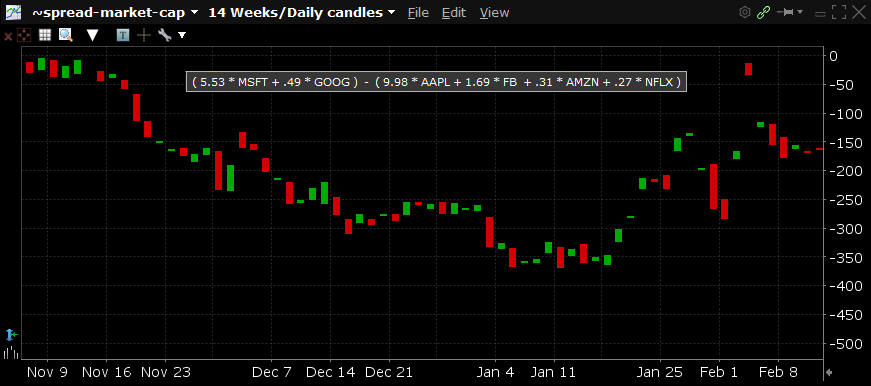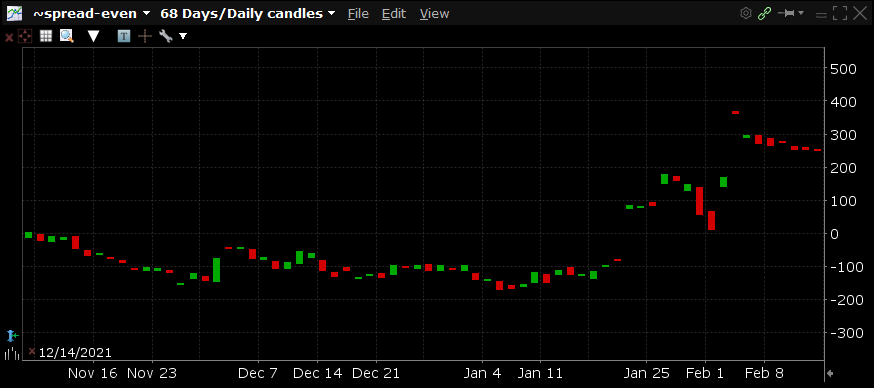Was the "all-in" spread trade a success?
- If you were a listener copying the trade when you heard about it on the all-in podcast, probably no
- If you were Chamath and avoiding taxes on your capital gains, probably yes
In episode 54 of the All-In podcast, Chamath brought up the idea of initiating a spread trade within big tech stocks as a way of protecting against a market downturn. It has been three months since the episode aired and we’ve already had a pretty good market correction with the possibility of some more to go. So, how did the spread trade do? If you had entered the trade when the episode aired would you have made money? Let’s take a look.
What is a spread trade?
The idea behind a spread trade is essentially to capture the changing difference between a pair of correlated positions. If you’re long a stock (you bought shares and are holding) you’re betting on the price of those shares going up. If you’re short a stock you’re betting on the the price of those shares going down. If you’ve entered a spread trade you’re betting that the price of the shares on the two sides of your position will, depending on how you setup your position, either converge or diverge.
Why would you want to trade a spread? Well, let’s consider the QQQ which is an index fund of the top-100 largest non-financial companies on the Nasdaq which includes both MSFT and FB among others. If the market as a whole experiences a major adjustment from something like a change in the price multiples that investors are willing to pay or a shift away from risky growth stocks towards defensive stocks due to changing economic conditions, MSFT and FB (both being large technology companies) will most likely be similarly impacted. However, due to the individual circumstances that apply to each company they will most likely not be impacted equally. While the QQQ is falling as a whole you could potentially still see a profit if, against your long MSFT position, you had an equally short FB position. That is, as long as the overall negative impact to MSFT is relatively better than the negative impact to FB you would come out ahead.
So what exactly was Chamath’s spread trade?
In the podcast Chamath sets up the two sides of the trade as the following: long MSFT and GOOG; short AAPL, FB, AMZN, and NFLX. Unfortunately that’s all the information that we were given so how to setup the actual allocations for the individual long and short positions is up to us to figure out.
The funds probably should be split 50-50 between long and short but the allocation among each company is a little less straightforward. The allocation that makes the most sense to me would be market cap weighted so that you own an equal portion of each company. This also makes sense given QQQ is market cap weighted which means inflows into the index fund would be allocated similarly to the position we’re setting up. Equal weighting is another option although using this kind of weighting would mean that you own a larger portion of the smaller companies and smaller portion of the larger companies.
The mcap stock ratio column shows how many shares you would have needed to buy (or sell for the short side) in each
company on Nov 8th to have a market cap weighted position. From the sheet we can see that if you opened this position
on on Nov 8th of last year with any amount of funds (using the provided stock ratio) your entire portfolio would be
down 2.42% as of Feb 12th (today).

As you can see from the chart, this position has never been positive but has been performing better as of late after less-than-stellar earnings reports from FB and NFLX.

The equal weighted spread trade faired better (up 3.73%), but that’s primarily because it was less exposed to the major driver that blew up this trade: shorting AAPL. Since the start of this trade AAPL has seen upward movement as much as 20% over it’s early November prices.
It turns out that one of the original reasons cited for having AAPL and AMZN on the short side of this trade, disruptions in global supply chains, turned out not to be that big of a deal after all. The latest all-in podcast had some opinions as to why that may be (in short, larger companies having more control over their supply chains).
So, was this trade a flop?
You wouldn’t think this trade was a flop by the self-praise it’s been getting in the latest episodes from the all-in podcast.
.@chamath called this spread trade in early november:
— The All-In Podcast 💧🐦 (@theallinpod) February 2, 2022
long $GOOG, $MSFT
short $FB, $NFLX, $AAPL, $AMZN
check out his explanation in this clip from e54… wow pic.twitter.com/BuvXBHdqfa
Yet if you were to have entered this trade Nov 8th (using my reasonable assumptions) you would be down 2.42%… so what gives? Was this a bad trade for Chamath? A quote from the latest episode signals to me why this trade would probably have been considered successful for Chamath (but not for you):
“I sold some of that high-growth tech, but then I also wanted to figure out a way where I could be less exposed to some of that volatility by continuing to hold what I had; and the best way that I figured out how to do that was to do the spread trade.” [emphasis added]
It’s important to notice that Chamath mentions he was already holding these tech companies that most likely comprised the long portion of his spread trade; and, after one of the biggest tech rallies in history, was almost certainly sitting on a significant amount of capital gains. So while we could have held cash to beat this trade (albeit lose to inflation) he has to sell his stocks to get to a cash position which requires him to pay somewhere between 20-40% on his significant chunk of capital gains. It’s almost a certainty that a 2.42% loss pales in comparison to the amount of taxes he would have paid to completely divest himself from his stock position.
From that we gather the moral of the story: don’t shadow trade billionaires.
<view-source on="" />